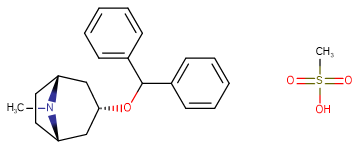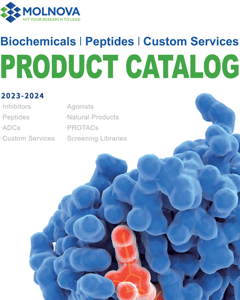
Benztropine mesylate
CAS No. 132-17-2
Benztropine mesylate( NSC 169913 )
Catalog No. M11297 CAS No. 132-17-2
Benzatropine is an anticholinergic drug used in patients to reduce the side effects of antipsychotic treatment.
Purity : >98% (HPLC)
 COA
COA
 Datasheet
Datasheet
 HNMR
HNMR
 HPLC
HPLC
 MSDS
MSDS
 Handing Instructions
Handing Instructions
| Size | Price / USD | Stock | Quantity |
| 500MG | 26 | In Stock |


|
| 1G | Get Quote | In Stock |


|
Biological Information
-
Product NameBenztropine mesylate
-
NoteResearch use only, not for human use.
-
Brief DescriptionBenzatropine is an anticholinergic drug used in patients to reduce the side effects of antipsychotic treatment.
-
DescriptionBenzatropine is an anticholinergic drug used in patients to reduce the side effects of antipsychotic treatment. Benzatropine is also a second-line drug for the treatment of Parkinson's disease. It improves tremor, but not rigidity and bradykinesia. (In Vitro):Benztropine mesylate (0.1-10 μM; 72 hours) treatment inhibits the cell growth of MDA-MB-231 cells with an IC50 of ~5 μM. In MDA-MB-231 cells and 4T1-luc2 cells, Benztropine mesylate reduces the size as well as the number of mammospheres significantly in a dose-dependent manne.Benztropine mesylate inhibits functions of cancer stem cells (CSCs) via the acetylcholine receptors, dopamine transporters/receptors, and/or histamine receptors.Benztropine mesylate induces the differentiation of oligodendrocytes through M1 and M3 muscarinic receptors and enhanced re-myelination.(In Vivo):Benztropine mesylate (1.5 mg/kg; daily; for 3 weeks; Balb/c mice) treatment significantly reduces both tumor size and tumor weight in a 4T1 mouse model.
-
In VitroCell Viability Assay Cell Line:MDA-MB-231 cells Concentration:0.1 μM, 0.625 μM, 1.25 μM, 2.5 μM, 5 μM, 10 μM Incubation Time:72 hours Result:Inhibited the cell growth of MDA-MB-231 cells with an IC50 of ~5 μM.Cell Proliferation Assay Cell Line:MDA-MB-231 cells Concentration:0, 1, 2, 5 μM Incubation Time:4-6 days Result:Suppressed mammosphere formation and self-renewal capacities of BCSCs in a dose-dependent manner in vitro.
-
In Vivo——
-
SynonymsNSC 169913
-
PathwayGPCR/G Protein
-
TargetDopamine Receptor
-
RecptorDAT
-
Research AreaNeurological Disease
-
Indication——
Chemical Information
-
CAS Number132-17-2
-
Formula Weight403.53
-
Molecular FormulaC21H25NO·CH4SO3
-
Purity>98% (HPLC)
-
SolubilityEthanol: 81 mg/mL (200.72 mM); Water: 81 mg/mL (200.72 mM); DMSO: 50 mg/mL (123.9 mM)
-
SMILESCN1[C@@H]2C[C@@H](OC(C3=CC=CC=C3)C4=CC=CC=C4)C[C@H]1CC2.OS(C)(=O)=O
-
Chemical Name(1R,3r,5S)-3-(benzhydryloxy)-8-methyl-8-azabicyclo[3.2.1]octane methanesulfonate
Shipping & Storage Information
-
Storage(-20℃)
-
ShippingWith Ice Pack
-
Stability≥ 2 years
Reference
1.Simoni D, et al. J Med Chem, 2005, 48(9), 3337-3343.
molnova catalog



related products
-
PNU-96391
PNU-96391 is an antagonist of dopamine D2 and a partial agonist of 5-HT2A. PNU-96391 can be used in research on the treatment of chronic diseases.
-
Rotundine b
Rotundine (L-tetrahydropalmatine L-THP) is a selective dopamine D1 receptor antagonist with IC50 of 166 nM.
-
Tavapadon
Tavapadon (PF 6649751, PF-06649751) is an orally available dopamine D1 receptor partial agonist for treatment of Parkinson's disease.



 Cart
Cart
 sales@molnova.com
sales@molnova.com


